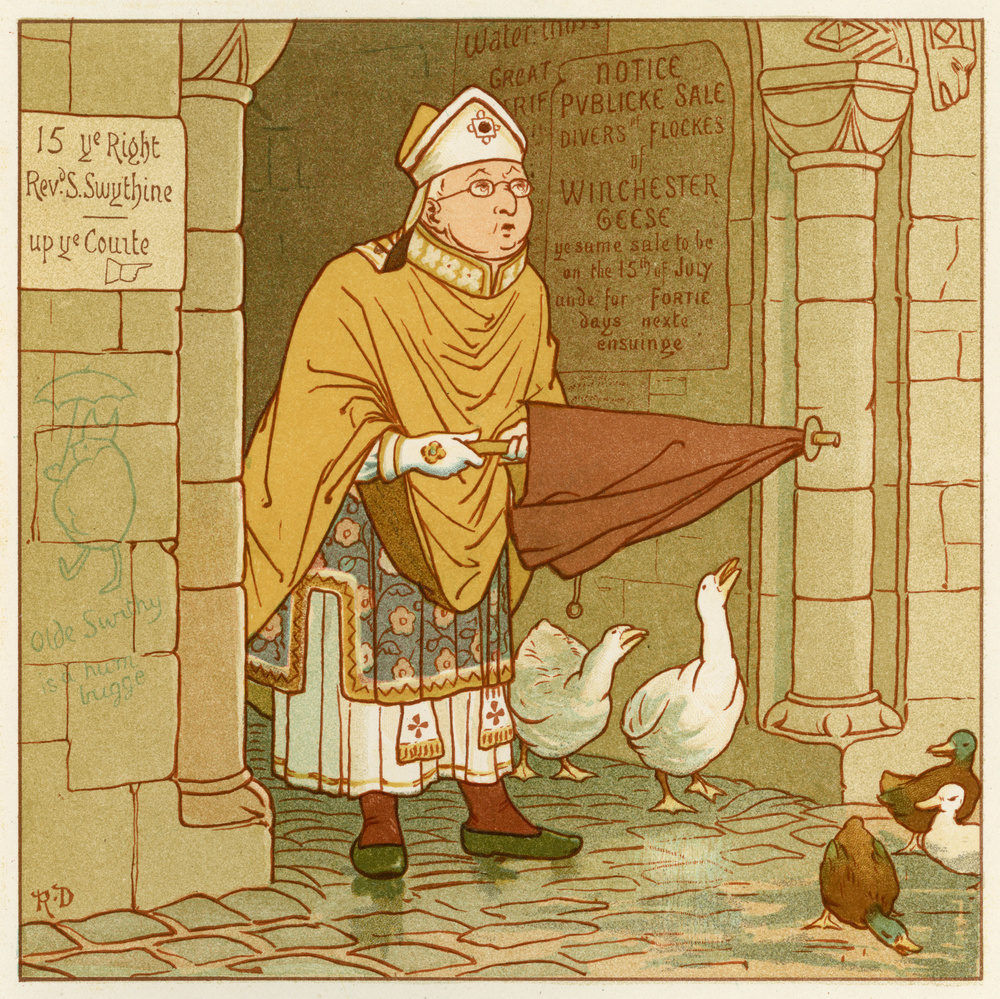Winchester Folklore

Winchester’s 2,000 years of history has been well documented, preserved and fastidiously researched. Perhaps though, it doesn’t tell us the full story of the city. What about the local tales passed down through generations that should come with a ‘citation needed’ warning? Take a pinch of salt and read my favourite stories from across the city.
The Great West Window
Starting with one of my favourites, it’s the Great West Window in Winchester Cathedral. The Cathedral is a grand building; there’s much to see inside, plus it’s a memorable place to graduate. However, one element that stood out when I went inside was how strange the main stained-glass window in the Cathedral really was. Unlike the other stained-glass windows, it didn’t depict anything, or tell a story, it was more of a psychedelic collage that looked as if it had come from the 60s (interestingly enough, Crosby, Stills and Nash do have a song, Cathedral which features Winchester Cathedral).
.jpeg)
The story, as I was told, is that during the Civil War in the 1640s, between the royalists and the parliamentarians, Winchester was captured early by the parliamentarians and the soldiers, who were slightly annoyed by a delay in their pay and decided the great Cathedral may hold some treasures to ease the wait until payday. Opening the tombs of early priests and kings yielded little except bones. Of course this didn't exactly calm things down. Those with muskets started using the great window as target practice and those that didn't, well... they decided to throw the bones of the former nobility through the window, destroying it. Once the soldiers had left, the townspeople flocked to the scene, collecting up all the glass and bones they could find and storing the pieces in boxes under beds in the hope that one day it could be rebuilt.
After almost 20 years, the monarchy regained control of the country, the Cathedral was windowless and rundown, and the time had come to bring out those boxes. Together, they reburied the bones and created the patchwork glass window we now see in the Cathedral. Originally, I wanted to believe the locals had created this broken yet beautiful pattern as a comment on the adversity they had faced. Unfortunately, it seems more likely that they tried quite hard to recreate the original windows but decided that was an impossible task.
William Walker
One of the first stories that greeted me on arrival to the city of Winchester was the story of how the Cathedral was saved from sinking into the ground at the start of the twentieth century. It wasn’t until a haircut a while later, that I learnt that it was saved thanks to the efforts of one man, a diver by the name of William Walker. Here are some of the best ‘facts’ I have found about him:
- It took him five years to complete the project, working seven hours a day in cramped pitch-black pits six metres deep.
- This is from 1906-1911, so the diving suit weighed 91kg and took so long to get on and off that Walker would only take his helmet off during his break to smoke his pipe and eat lunch.
- The original estimated cost was £20,000 in 1905 but ended up costing £113,000 by 1912 (almost £11m in 2024 money). Almost 1,000,000 bricks were used by the end of the project.
- He lived in Croydon and cycled to Winchester every week.
- His second wife was the sister of his first wife.
- The first statue of William Walker was unveiled in 1964, and immediately a mistake was spotted. It wasn’t him. The artist had accidentally created a sculpture of Francis Fox, the civil engineer for the project, who was also in the photo provided. It was corrected in 2001.
You can raise a glass to the man in the aptly named William Walker pub, just a stone’s throw from the Cathedral.
-min.jpg)
Thomas Thetcher
You probably already know that writer Jane Austen in buried at Winchester Cathedral. But did you know Thomas Thetcher, a grenadier in the Hants Militia, is also buried in the graveyard? His name may not be familiar but the message on his gravestone features in one of the best-selling publications of all time.
A curious gravestone was commissioned when he was buried, which is how we learnt that he wasn’t killed in the line of duty but rather by a drink. Yes, Thomas Thetcher died of a ‘Violent fever contracted by drinking Small Beer when hot’. The cause of death is not exactly known, but it’s believed that the beer Thomas drank was likely contaminated and caused an infection.
Thetcher’s legend grew to numerous misinterpretations of the quote and the most famous example of this comes from Bill Wilson, an American soldier who was stationed in Winchester in 1918. After returning to America, Wilson began drinking so heavily that he believed his life was at risk. After working with others in the same position, and maintain sobriety, Wilson wrote the book Alcoholics Anonymous where he recounts his visit to the gravestone and paraphrased the first and last parts of the grave on the first page of the book.
St Swithun’s Weather Forecast
St Swithun is a big part of the history of Winchester. The Bishop was well liked for his acts of kindness towards the poor and the needy and remembered for his building of bridges to help connect the city and allow traders to enter. He died in 862 and became the centre of many posthumous miracles and legends. His one wish upon death was to be buried in a simple grave, where the rain could fall on him and people could walk by. However, after a century of rest he was moved into the Cathedral and after that day, July 15, it was said to rain for weeks. This is where legend arose that if it rains on St Swithun’s Day then it will continue to rain for 40 more days and if it’s dry, then it will be dry for the following 40 days. Next July 15, keep an eye on the weather.

The Phantoms of Winchester
Winchester has a gruesome history of executions, with many having been carried out across the city for hundreds of years. In fact, the last public execution in Winchester was in 1864, the last triple execution in 1896, and the last only in December 1963.
Another of the 'lasts' that happened in the city was the last beheading of a woman. Lady Alice Lisle was executed in The Square after a controversial trial in 1685. Lady Lisle was originally sentenced to be burned at the stake, though this was later changed to beheading, which is often claimed to have been an act of mercy by James II, though it’s more likely that it was changed because of her social rank. Lady Lisle spent her last night at The Eclipse Inn, the black-and-white Tudor pub that is still open just off The Square. Since then, patrons have claimed to have seen visions of a slender woman and bedsheet being pulled off them in the night.
The Jolly Farmer pub on Andover Road also supposedly sits on a former public execution site that was known to locals as ‘Gallows Hill’. With that history, it’s not a surprise that customers have ‘felt’ the grip of Henry, a man executed on the site, on their shoulders as they drink in the pub.
These are just some of the local legends that I’ve learnt about Winchester in my time here. There’s plenty more out there, some which couldn’t be published on this blog, for you to discover when you arrive.
Back to blog